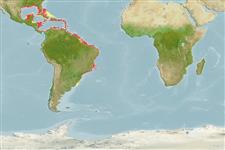Common names from other countries
Environment: milieu / climate zone / depth range / distribution range
Ecologia
marinhas; Água doce; estuarina demersal; anfídromo (Ref. 46888). Tropical; 25°C - 30°C (Ref. 97140); 32°N -
Northwest to western Central Atlantic: Bermuda, Bahamas, South Carolina and northern Gulf of Mexico in USA to southeastern Brazil.
Tamanho / Peso / Idade
Maturity: Lm ? range ? - ? cm
Max length : 25.0 cm TL macho/indeterminado; (Ref. 7251); common length : 12.5 cm TL macho/indeterminado; (Ref. 12193)
Descrição breve
Chaves de identificação | Morfologia | Morfometria
Espinhos dorsais (total) : 7; Raios dorsais moles (total) : 9; Espinhos anais: 0; Raios anais moles: 9.
Adults are found on shallow, muddy or sandy bottoms (Ref. 13628). They appear to prefer estuarine freshwater tributaries, occurring in waters with a salinity range of 0 to 19 ppt (Ref. 7251), or up to 36.6 in some cases (Ref. 97140). Feed on dipteran larvae and pupae (especially the juveniles); crustaceans like crabs and shrimps; and small fishes. The diet changes with sexual maturity and season. Gonadal development takes place during the dry season. Average size at maturity is 5.7 mm for males and 4.3 mm for females (Ref. 35237).
Life cycle and mating behavior
Maturities | Reprodução | Spawnings | Egg(s) | Fecundities | Larvas
Robins, C.R. and G.C. Ray, 1986. A field guide to Atlantic coast fishes of North America. Houghton Mifflin Company, Boston, U.S.A. 354 p. (Ref. 7251)
Categoria na Lista Vermelha da IUCN (Ref. 130435)
CITES (Ref. 128078)
Not Evaluated
Ameaça para o homem
Harmless
Utilização humana
Ferramentas
Relatórios especiais
Descarregue XML
Fontes da internet
Estimates based on models
Preferred temperature (Ref.
115969): 23.4 - 28.1, mean 27.2 (based on 808 cells).
Phylogenetic diversity index (Ref.
82804): PD
50 = 0.5000 [Uniqueness, from 0.5 = low to 2.0 = high].
Nível Trófico (Ref.
69278): 3.7 ±0.4 se; based on diet studies.
Resiliência (Ref.
120179): Médio, tempo mínimo de duplicação da população 1,4 - 4,4 anos (Preliminary K or Fecundity.).
Fishing Vulnerability (Ref.
59153): Low vulnerability (15 of 100).
